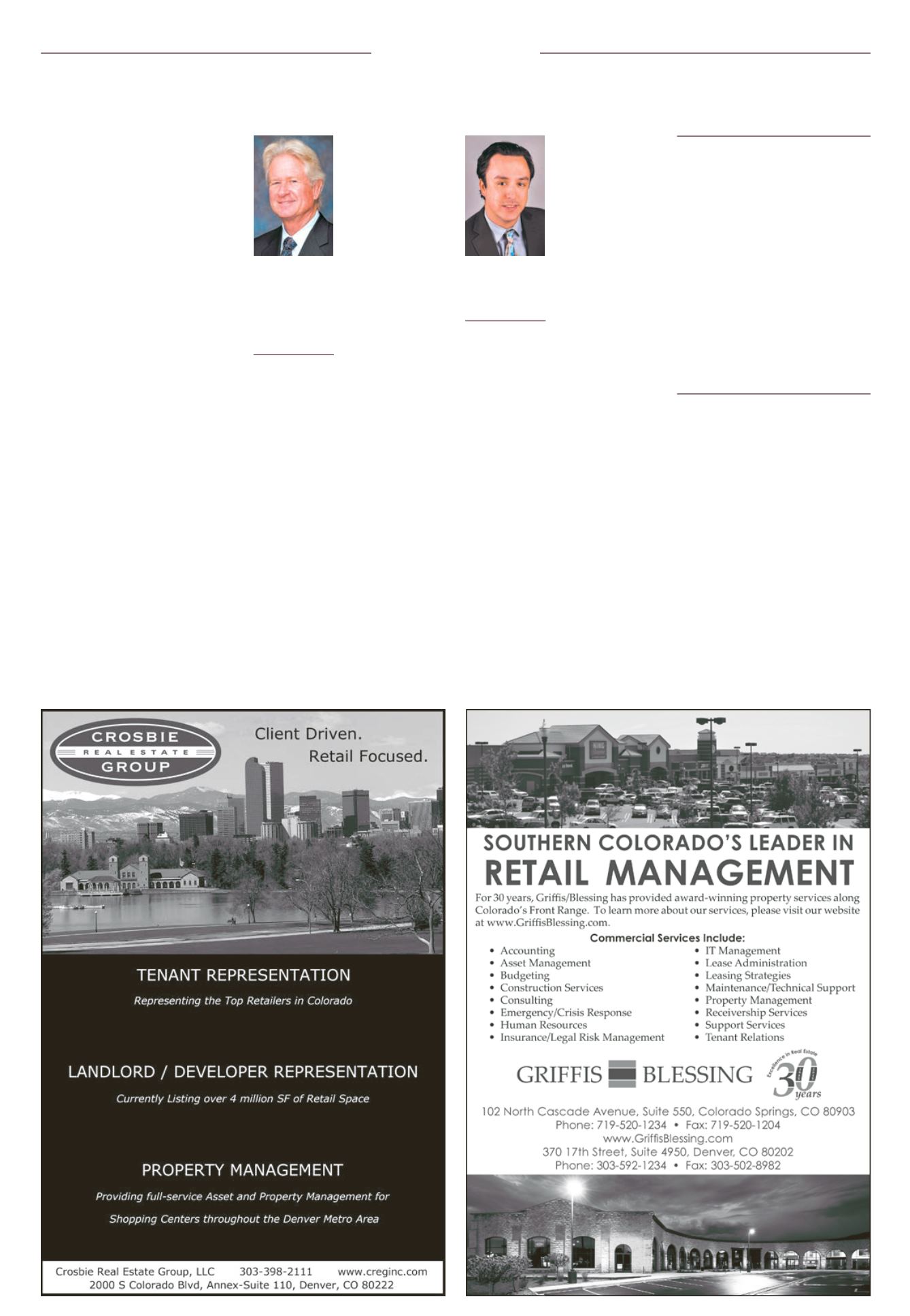

February 2015 — Retail Properties Quarterly —
Page 13
S
trong job growth, a diverse
and expanding economy, fall-
ing vacancy rates, increasing
rental rates and a continued
increase in demand from
national and international inves-
tors made 2014 a good year to own
a retail investment property in the
Denver-Boulder metro area.
As we head into 2015, the follow-
ing top four trends will shape retail
investment results for investors in
Colorado:
1. The desire for yield will con-
tinue unabated as financial assets
continue to produce very low yields.
This will result in continued cap rate
pressure as demand for retail real
estate remains strong.
2. The oil price “collapse,” if sus-
tained, will boost consumption,
benefit retailers and increase retail
sales, but will be a double-edged
sword in some economies where
energy employment is significant.
3. Continued improvement in job
growth, reduced unemployment and
increasing retail sales will result in
increased demand for retail space,
helping to reduce overall vacancy
and increase rental rates.
4. A modest increase in new retail
construction will result in positive
net absorption and keep supply and
demand for retail space in relatively
healthy balance.
In addition to the strong funda-
mentals, the continued low inter-
est rate environment has resulted
in considerable investor interest
in purchasing and owning retail
properties. Investment yields on
traditional financial assets, Treasury
securities, corporate bonds and sav-
ings accounts are
very low by historic
standards, result-
ing in investors
across all spec-
trums seeking real
estate investments
to achieve higher
rates of return.
The result has
been downward
pressure on cap
rates, as buyers
seek retail invest-
ments financed
at historically low
rates, making deals
attractive at cap
rates that only a
few years ago would not have made
any sense at all.
Post-recession investment sales of
multitenant shopping centers in the
Denver-Boulder metro area gener-
ally have seen the most velocity in
grocery-anchored shopping centers
and Class A power/lifestyle centers,
which are heavily sought after by
institutional buyers, on one end of
the spectrum; and, distressed/value-
add properties, generally targeted
by more entrepreneurial investors,
on the other end. In 2014, Class A
properties generally sold at aggres-
sive cap rates as interest rates fell
(80 basis points over the course of
the year), loans were available with
increasing leverage at very low rates,
and additional demand was created
by an influx of national and interna-
tional institutions.
Noninstitutional, private-party
investors and investment groups,
which had been active multiten-
ant retail investors
for years, gener-
ally have been
disappointed at the
small number of
distressed or value-
add opportunities
with achievable
upside available
over the last few
years, and either
have withdrawn
from the market
or substantially
reduced their
transaction veloci-
ty. Some have begun targeting small-
er redevelopment projects in densely
populated, infill areas. Recently we
also have seen these “upside” entre-
preneurial investors attempting to
acquire Class B and C properties for
existing cash flow, without an obvi-
ous value-add angle, but these prop-
erties remain a small portion of the
post-recession market due to a very
limited supply.
A part of the market that has
seen a sizeable increase in demand
recently is the market for smaller
multitenant properties leased to
high-quality tenants. The 1031
exchangers who flock to single-
tenant properties with long-term
leases in place increasingly have
been discouraged by the low capi-
talization rates that these properties
command. Many of these buyers
have turned to small multitenant
retail strips with two to five tenants,
and have very low management
requirements due to the discrepancy
in capitalization rates. This increase
in demand has put downward pres-
sure on capitalization rates for these
properties, but small multitenant
strips still remain a good value in
comparison. What remains true
across all spectrums of multitenant
retail properties is that the supply of
such properties is limited relative to
demand, and there is an abundance
of buyers chasing the properties
that are properly marketed. It is very
much a seller’s market.
The dramatic drop in oil prices
(under $50 a barrel when this
article was written) will result in
an increase in disposable income.
Consumers will have more money
to spend on discretionary items,
and the boost in overall spending is
expected to benefit the retail indus-
try and shopping centers in general.
The seller’s market continues for Colorado retailRetail Insider
Garrette
Matlock
Senior vice
president,
Investments,
Marcus & Millichap
National Retail
Group, Denver
Ryan Bowlby
Senior financial
analyst, The
Matlock Group,
Denver
Please see ‘Insider,’ Page 23A part of the market
that has seen a
sizeable increase
in demand recently
is the market for
smaller multitenant
properties leased to
high-quality tenants.
















